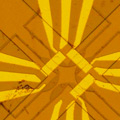Oct 22 2010
At the heart of the method is a so-called quantum point contact (QPC). This is a narrow conductive channel in a semiconductor circuit.
The scientists created a 70-nanometer narrow channel, about as wide as the wavelength of electrons in the semiconductor. The key is that only one electron at a time will fit through the channel, making possible extremely high-precision measurements of the electric current. As described in the current publication, this method was applied to photogenerated electrons for the first time ever.
 Circuit with quantum point contacts
Circuit with quantum point contacts
In the experimental set-up it is not the sun, but rather a laser beam that kicks the electrons into their excited state. These electrons are then analyzed using a quantum point contact. In the process, the scientists were able to demonstrate for the first time that photogenerated electrons can flow several micrometers before colliding with crystalline atoms. They also established that the geometric form of a circuit has a strong influence on electron paths. Electrons can even "run around corners" when they rebound from circuit boundaries, not unlike billiard balls.
The insights and analytic opportunities made possible by this novel technique are relevant to a whole range of applications. These include, most notably, the further development of electronic components such as photodetectors, high electron mobility transistors (HEMT), and components that utilize the magnetic spin of electrons to process information.
Source: http://portal.mytum.de/